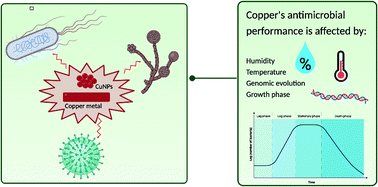Copper as an antimicrobial agent: recent advances
Abstract
From its uses in ancient civilisations, copper has an established history as an antimicrobial agent. Extensive research has determined the efficacy and mechanism of copper's antimicrobial activity against microorganisms. The process is multifaceted with the main mechanism of bactericidal activity being the generation of reactive oxygen species (ROS), which irreversibly damages membranes. Copper ions released from surfaces lead to RNA degradation and membrane disruption of enveloped viruses. For fungi, the mechanism involves the physical deterioration of the membrane and copper ion influx. Due to variations in the experimental parameters, it is difficult to compare studies directly. In this review article, we outline the importance of the experimental conditions currently employed and how they bear little resemblance to real-world conditions. We endorse previous recommendations calling for an update to industrial standard tests.

- This article is part of the themed collection: 2021 Reviews in RSC Advances


 Please wait while we load your content...
Please wait while we load your content...